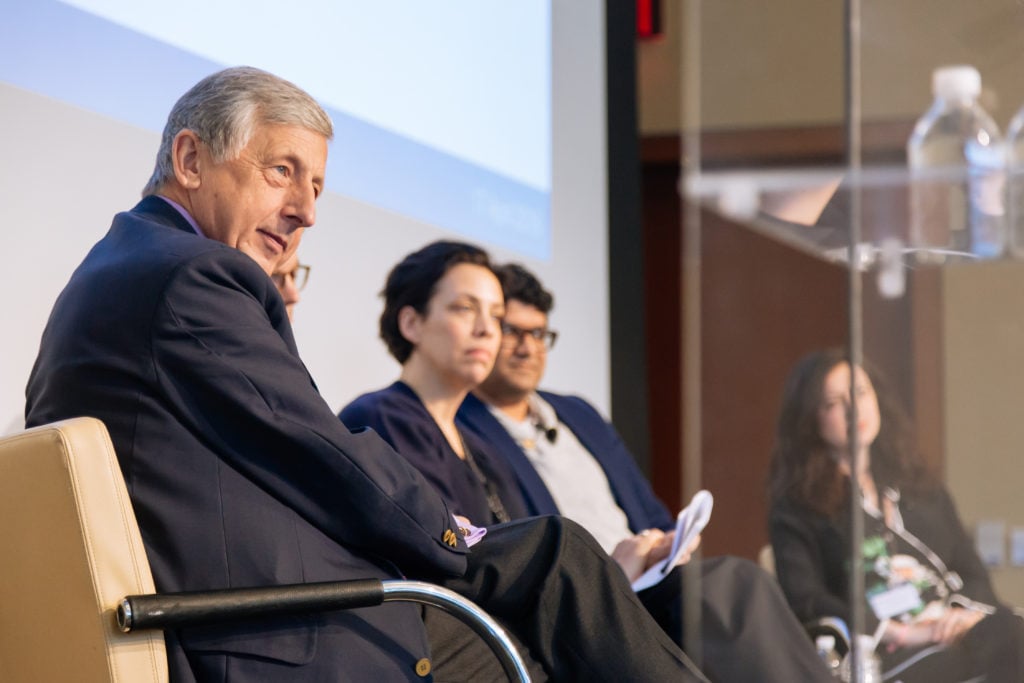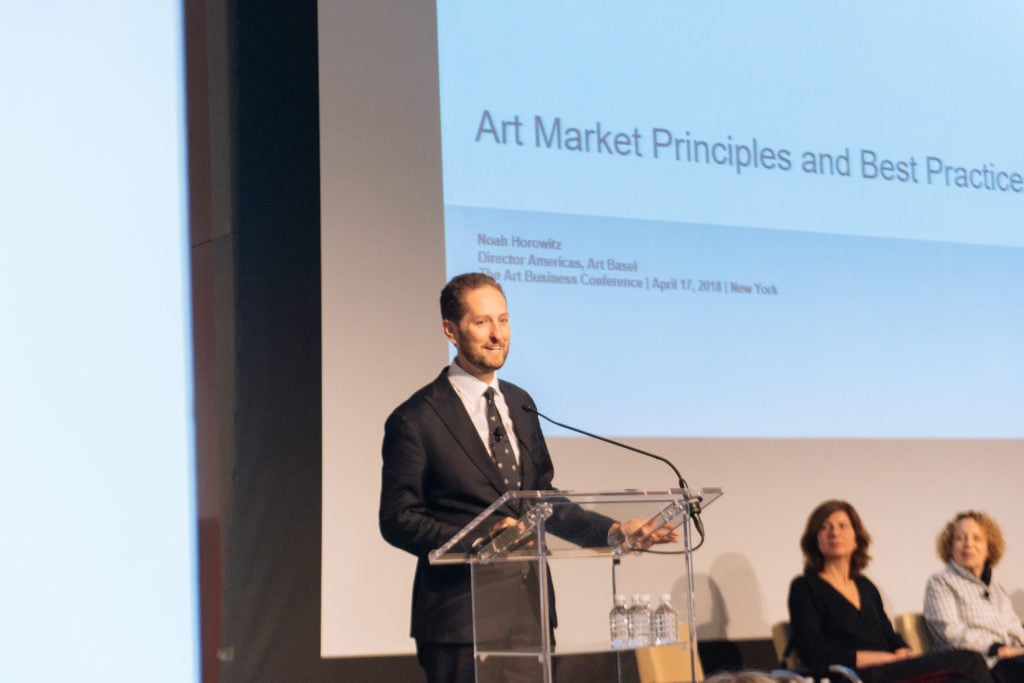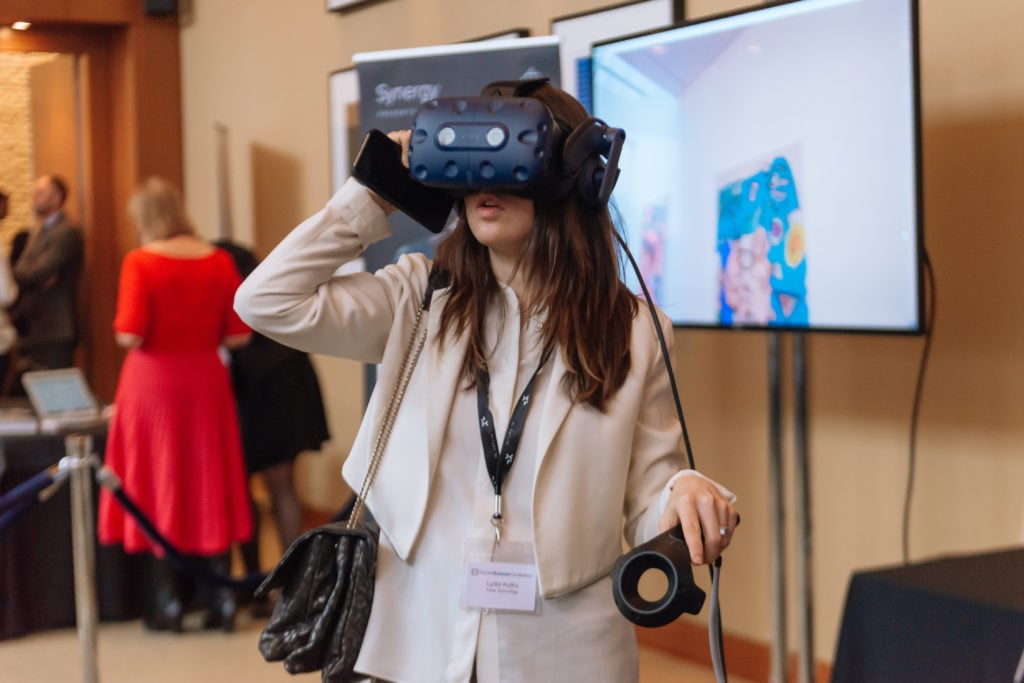Analysis
3 Ways the Art Industry Is Still Resisting Change—and Why the Market Is Doomed If It Doesn’t Catch Up
We capture the three most pressing ideological tensions that came out of this year's Art Business Conference in New York.

We capture the three most pressing ideological tensions that came out of this year's Art Business Conference in New York.

Tim Schneider

Earlier this week, a cross-section of art industry professionals converged in Midtown Manhattan to debate some of the market’s most urgent questions. Hailing from around the globe and across sectors, participants in the second annual Art Business Conference in New York dissected topics ranging from the practical (see: how to guard your data against malicious hackers) to the philosophical (see: how to steward an artist’s legacy).
We’ve packed the most important themes into an easy-to-digest capsule for anyone not in attendance. And since every good medicine is just the result of chemical reactions, here are the three main ideological collisions on display at the conference—and why they matter so much for where we go next.

Philip Hewat-Jaboor and co-panelists at the Art Business Conference New York 2018. Courtesy of the Art Business Conference.
Most readers won’t have to be returned to consciousness with a syringe full of adrenaline, Pulp Fiction-style, after hearing that this struggle first emerged in a panel discussion called “The Future of Collecting.” But the world of galleries, art fairs, and auction houses was far from the only context in which the issue appeared. Presenters underscored the value of free and fair exchange—and the dangers of its absence—when discussing everything from the scholarly fundamentals of constructing a reliable catalogue raisonné to the business mechanics of traveling museum exhibitions.
There were signs of sunlight breaking through from unexpected corners. Philip Hewat-Jaboor, now chairman of Masterpiece Fairs after 46 years in the art business, declared that one of his “pet projects” was to make sure his events’ exhibitors included prices on all their wall labels—a goal informed by “so much firsthand evidence” that such openness helps lubricate sales.
Hewat Jaboor’s co-panelist Aviva Lehmann of Heritage Auctions also broadcast the house’s intent to become the “most transparent” in the sector. She pointed out that Heritage already posts the reserve prices for all applicable lots a week before the sale date and opens bidding for online-only sales a month early, so that potential buyers can get a sense of the level of interest in advance.
But other presenters noted that the art world still has a long ways to go, even outside the sales realm. Tiffany Bell, who played pivotal roles in the catalogues raisonnés of Agnes Martin and Dan Flavin, emphasized that an artist’s foundation needs to know what works still survive, in which hands, and in what condition, if they ever hope to do justice to a creative legacy. This basic information can still be unnecessarily difficult to obtain thanks to the information-hoarding tendencies of many collectors, dealers, and even friends and confidantes of the artists themselves.
David Grosz, the president of catalogue raisonné publisher Artifex Press, said his company chooses to work strictly with artists whose careers (and presumably, lives) “can stand the full truth”—an impactful statement when so many alleged masters are being “rediscovered” by a hungry market, and so many figures are (finally) being aired out for histories of exploitative behavior.
THE TAKEAWAY: While it’s important for dealers (particularly smaller ones) to ashcan the secrecy-driven elitism of the traditional art sales process, transparency needs to be thought of in a much broader sense for the arts to grow in a healthy way.

Noah Horowitz and co-panelists at the Art Business Conference New York 2018. Courtesy of the Art Business Conference.
It might have been possible to go through the day’s program without registering the rapidly growing complexity of the art business. But it would have been about as difficult as biting into an uncooked potato like a ripe apple.
From the challenges of globalization to the escalating scale of exhibitions to the labyrinthine nature of 21st-century courtroom battles, the conference clarified that we are light-years past dealing with a cottage industry. The question is: How are people at all levels of the market going to respond to this new reality?
Unsurprisingly, the top of the market seems to be the best prepared. The panel on “Art Market Principles and Best Practices” was structured around a presentation from Noah Horowitz, Art Basel’s director of the Americas, on the fair’s recently released document of the same name, which aims to codify a broad list of do’s and don’ts for good actors in the market.
I have been (and remain) supportive of this initiative, partly because it puts pressure on the rest of the for-profit sector to ante up on establishing and abiding by an industry-specific code of conduct, not just government laws regulating commerce in general. (Reminder: The quickest way to know that someone has no idea what they’re talking about is if they declare that the art market is “totally unregulated.”)
But if other spheres of the art market don’t raise the bar themselves, it increases the odds that external regulations will be imposed by clueless politicians whose efforts could actually make matters worse, as longtime art lawyer Jo Backer Laird expressed (in more diplomatic terms).
As a thought exercise, just look at the dangerous blind spots in the US’s recently passed Stop Enabling Sex Trafficking Act, or run back through the lowlights of Congress’s bumbling questions to Mark Zuckerberg about how Facebook works. Then ask yourself how much havoc could result if more scandals motivated someone like Ted Cruz or Boris Johnson to legislate the art industry after reading two Jonathan Jones reviews and half-watching Exit from the Gift Shop.
“Traveling Exhibitions,” the panel I moderated, drew a stark picture of the challenges and stakes beyond the regulatory realm. It demonstrated that legacy firms like fine-art insurers have grown tremendously, and intriguing startup businesses have reached viability, in response to the unmet needs of collectors, venues, and artists alike.
Art has become too expensive (see: fine art coverage of collections valued at billions of dollars), too complex (see: Nick Cave installations consisting of 10,000 individual components), and too globally mobile (see: ocean freight transport where a container of masterpieces could be endangered by an adjacent, rat-attracting container of soybeans) to keep handling with handshakes and ad-hoc plans.
Even legal practice is evolving to adapt to the present-day art market. An afternoon session headlined by art-law attorneys Noor Kadhim and Daniel McClean focused on litigation financing, a practice in which a third party funds one claimant in a lawsuit in exchange for a piece of the upside if they emerge victorious. Restitution battles are one obvious use case, given both how long they can drag out and how large their rewards can be. Just look at Maria Altmann’s five-year battle to win back Gustav Klimt’s Adele Bloch-Bauer I—and its subsequent sale to Ronald Lauder for $135 million.
THE TAKEAWAY: DIY might work as an aesthetic, but it’s an increasingly dubious way of doing business in the arts. And while that’s a boon for those with the capital and resources to collaborate with top professionals across the board, it raises serious concerns about how everyone else can keep up.

The Art Business Conference New York 2018. Courtesy of the Art Business Conference.
Like a high school freshman who swears off three years of dating to focus exclusively on SAT prep, the conference simultaneously gave us reason to be encouraged and concerned about the industry’s relationship to technology. To me, the ultimate conclusion depends on whether it’s wiser to focus on the presenters and panelists, or the audience and its reactions.
On one hand, the event featured a surprising amount of digital innovators. Bernadine Bröcker-Wieder communicated the logic behind her online platform, Vastari, which seeks to efficiently and transparently connect the various players in the exhibition ecosystem, from collectors who want to lend artwork to venues that want to borrow it to intermediaries who produce shows around it. Magnus Resch was on hand to champion his namesake price-transparency app, Magnus, still newly empowered by an investment from Leonardo DiCaprio. The day even ended with Sotheby’s Jennifer Deason—a self-described non-technologist—showcasing some of the house’s recent explorations into computer vision, machine learning, and taste profiling. (It’s not dissimilar to how Netflix’s algorithms recommend what to watch next based on what you’ve watched already.)
Although I was intrigued, it’s safe to say this is not how I expected the event to wind down. And it seemed like the same could be said for most of the other attendees within earshot of me. However, the tone of our responses diverged dramatically.
Granted, I’m a lot more familiar with this stuff than even a lot of my peers in the arts, let alone the older demographic that made up much of the conference’s audience. But the whispers I heard during Deason’s presentation, as well as during a short session on cybercrime, could have been plausibly used as background audio for the moment in a sci-fi movie between when a mysterious object crash-lands in a pasture and when it rises out of its smoking crater to begin blasting lasers at every curious farmhand in sight.
Similarly, when cybersecurity expert Aaron Aanenson advised the crowd to use two-factor authentication on their webmail, it was greeted like a revelation. If you want to know why that’s troubling, the link in my last sentence goes to a CNET post written in 2015. To quote my dad, an IT professional himself: Yikes.
THE TAKEAWAY: Technology is coming for the art world, whether the art industry is ready or not. The Art Business Conference should be applauded for giving the subject as much stage time as it did. But it will be the industry’s loss on multiple levels if it runs from the changes instead of meeting them head-on.